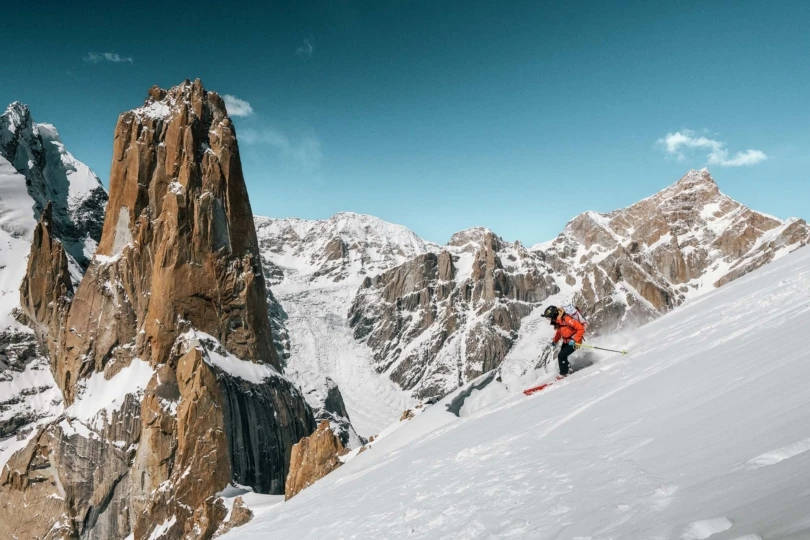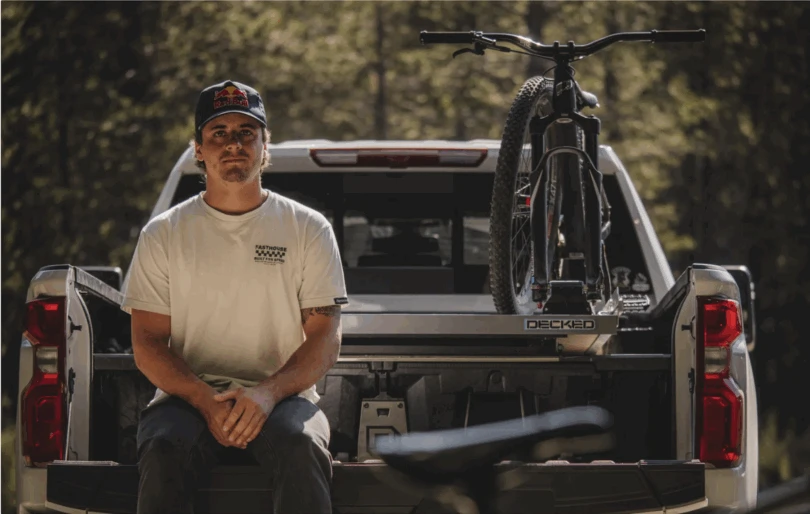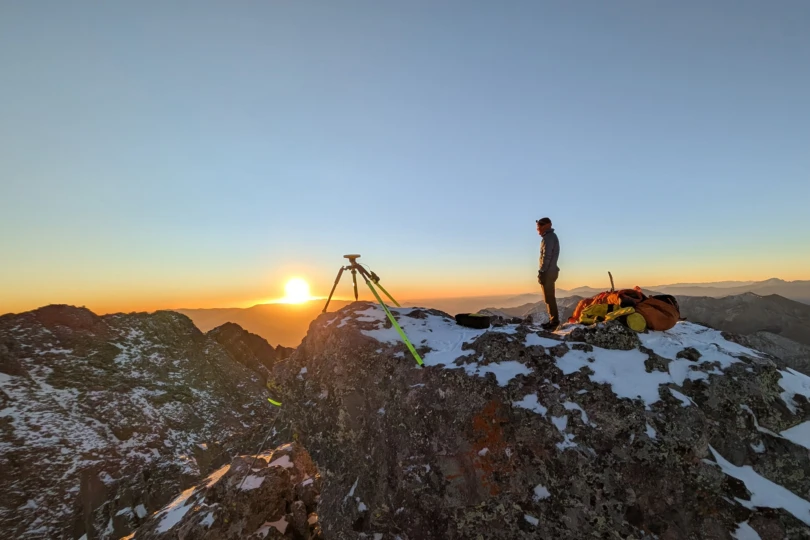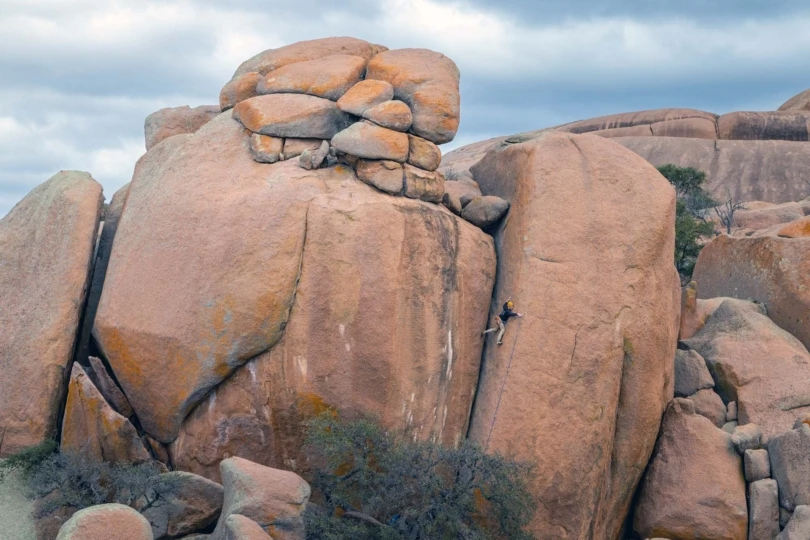Your climbing harness could be new or old, pristine or tattered — if it doesn’t fit, you’re in for a long day out no matter what.
Our day out on Red Rocks’ “Unimpeachable Groping” had proceeded like a dirge. We’d shown up early, but it turned out we were already behind a few other parties. An hour and a half into the backcountry without a suitable backup option nearby, we looked at each other and shrugged, and then got in line.
The 700-foot climb unfolded slowly. When my partner and I could move, we made adroit upward progress, but we spent most of the day hung up amid the other, more gradually ascending teams. A dearth of belay ledges at tightly bolted anchors meant lots of time slumping in our harnesses, hanging like sacks of potatoes as we waited for our chance to go.
View this post on Instagram
(Happily, the times of social distancing were in the past. But you get the idea.)
Still, we topped out more or less as planned and began the somewhat circuitous descent. As I leaned back into one low-angle rappel, a constrictive heat suddenly gripped me high on my hips.
There was no mistaking it: I was chafing hard. This part of the rappel was more or less a backward walk, and the rope hung heavily straight downward below. To make progress here, I had to lean back intently.
“Groping” is right, I thought. There was nothing I could do; it was harness burn for me.
I woke up the next day with angry purple raspberries on my soft love handles.
But in fact, there was something I could have done — just not at the time. If I’d been wearing the right harness fitted properly, the belt would have aligned better around my waist and the padding would have protected my vulnerable bits. In fact, harnesses have put me in some binds that have compromised my, ahem, even more vulnerable bits.
Fitting a climbing harness may seem straightforward. But what parts should sit where on your body? How do you target a purpose-specific harness for whatever kind of climbing you’re into? Most critically, how do you keep from getting chafed on a long day out?

In the field, the answers all present more or less moving targets. But observing some best practices can help you find your way toward the balance point between comfort and performance.
Editor’s Note: Rock climbing is an inherently dangerous activity. As with any outdoor sport that entails risk, you should start slow and at a level suitable to your experience. Above all, you should consult with someone more experienced than you to help guide you in fitting and using your first harness.
Sizing a Climbing Harness
By far, the most important part of fitting your harness is making sure you get the right size. Like men’s pants, climbing companies generally size harnesses according to waist circumference in inches. Of course, there’s a range because every harness is adjustable.
If you’re looking at a harness and you fall right in the middle of one of the size ranges, it’s probably safe to go for it. You’ll still want to consider a couple of things; if you’re on one cusp or the other of a size range, you’ll definitely want to pause.
For instance, I’m a size 29 waist. Let’s say I’m looking at a harness where a size small covers 27-30 inches. It looks like I should go for that, but I’ll want to think about how I’m going to wear it first.

To size a harness according to my waist, I consider three parameters:
- What kind of pants will I be wearing under it?
- How many layers of shirts, jackets, etc., do I want to fit under it?
- What will I be carrying on it?
You can probably see how this game plays out. My fair-weather sport climbing kit is pretty much jorts or board shorts, plus a tank top and six quickdraws. If that sounds roughly like you, you can get away with a harness that fits close to your body, and you don’t need huge gear loops — or even very many of them.
On the other hand, you might need a rig for multipitch routes in the middle of nowhere. You’ll be logging some time at belay stations and on rappel. In that case, think about a long day out and a more robust kit.
If you want to fit two layers plus a jacket under the waist belt, you’d better plan to size up at least 2 inches — especially because in that case, you’ll probably be hauling a ton of kit up the wall. This brings us to our next point.

If Your Harness Doesn’t Fit, Neither Will Your Gear Loops
You’ll also probably want to nail your waist size because if you don’t, your gear loops might end up in awkward places. If you think about it, yes, the size small harness in the example will adjust to fit a 27-inch waist or a 30-inch waist — but the only way to do it is to cinch the strap until it’s tight. The gear loops, obviously, stay put where they are on the belt.
Say you have 3 inches of leftover strap on your harness that cinches to the left. This means the gear loops on your left side will be 3 inches farther left. It may not seem like much, but that’s actually plenty of distance to position the rear gear loop almost completely behind you.
The resulting disadvantage is obvious. I’ve personally found myself flailing for gear all the way behind me, with the opposite hand, gripped on a hand jam I can’t remove because if I do I’ll fall off onto my last piece 15 feet below me.
Case in point: me, several years ago in Zion. My left rear gear loop is situated almost in the middle of my back, so I’m compensating by overloading the loops on my right.
View this post on Instagram
The subjective merits of such a scenario (“head game,” or simply experiencing abject fear without a soft escape option) are another topic. For our purposes, it’s easier to assume you don’t want to end up in one.
In that case, I’d recommend sizing your harness generously for long climbs or gear-intensive routes like Indian Creek cracks or aid climbs.
Harness Padding and Common Sense for Whippers
Another good reason to size up on long or otherwise punishing climbs is that it’ll give you more padding. Manufacturers generally design smaller harnesses for people with smaller bodies. Not only do they make bigger harnesses bigger around, but they also pad them more substantially.
To a degree, it’s a simple matter of scale. But there’s also a comfort component. If you weigh 225 pounds, you’re going to whip with a lot more force than somebody who weighs 125. Anybody who’s done it knows exactly where that force transfers at the end of the rope — right through the harness into the climber’s hips and back.
If you’re going to fall a lot, more padding is generally a good thing. Sizing your harness up slightly to add a little more bulk can help.
That’s all true on the other end, too. If you belay someone who falls a lot, you’ll also want a wider belt — because the force of their falls will hit you in the lower back. (And, to a degree, your nethers. More on that later.)
For context on a personal note, I’ve done all of this a fair amount. Back when I was grinding out sport redpoints at my physical limit, I fell a hell of a lot. So did my main climbing partner, who weighed an average of 75 pounds more than I did.
To absorb that monstrous sweetheart’s fearsome whippers, and plummet into my own, I found a size medium Metolius Safe Tech worked best.

Why?
Metolius pegs that rig’s range at a 30-33-inch waist. My waist is size 28. However, cinching it up as tight as it would go made it reasonably tight around a pair of swim trunks and a tank top. And I consider the stress savings on my back substantial.
Taking long rides in both directions — down when I would fall and violently up when my king-size partner would fall — didn’t typically result in perceptible tissue damage at any depth, thanks to the harness’s fat width in the lumbar area.
Leg Loops and Avoiding Crushed Bits
Sizing for harness leg loops is far less critical. That’s because leg loops focus primarily on comfort and help guide the direction of load.
In short, think about what could happen if you tied into a harness that was just a belt; your tie-in point could dance around on the circumference of your waist. And if you fell, or caught a fall, the rope could rag-doll you from almost anywhere on your body.
Comfort-wise, I’ve found that I (and most people) prefer to cinch their leg loops snugly around their crotch. I’ve hung loose before, but in my experience, wild rides on loose leg loops lead to crushed bits.
I’m not sure what it would be like to do it with the other variety of bits, but I can’t imagine it would be much more pleasant.
To that end, you’ll likely prefer a harness with adjustable leg loops if you’re going to deal with falls a lot. Arguably, riser (the garter-like vertical ribbon in the back) adjustability is more important than loop size adjustability. As long as you can snug the loops upward toward your crotch, you should be able to get them tight enough to stay put.

Also, most harness leg loops that do adjust (exceptions: ultralight rigs for weight goons like extreme alpinists and high-standard redpointers) adjust widely.
Caveats and Conclusions
Fitting your harness right always requires hitting a moving target. No perfect, comprehensive answer exists. Different harnesses, clearly, suit different purposes.
And between the specific size of your various body parts, what gear you carry, and how much layering and delayering the day requires, the parameters can shift. It can even happen on a same-day basis.
But utilizing the above criteria can demystify the project to a degree. And depending on the day, it could save you a nasty encounter with soft tissue pain.










